This post contains affiliate links. Please see our disclosure policy.
Discover effective stretching exercises for plantar fasciitis relief! Learn gentle, targeted stretches to reduce heel pain, improve flexibility, and support recovery, helping you stay active and pain-free.
Plantar fasciitis can be a painful roadblock in daily life, especially for those who love staying active. But the good news is, stretching can be a powerful tool for relief!
The stretches below will help loosen tight muscles, increase flexibility, and support your recovery journey.
Whether you’re dealing with occasional flare-ups or chronic discomfort, adding these exercises to your routine can make a big difference!
Regular and consistent stretching is going to be key for any plantar fasciitis treatment plan. It is best to do each exercise not only daily but in some cases several times a day.
The good news is they can be spread out throughout the day. Here’s a sample of how to easily work them into your daily routine.
Make sure you do these for BOTH of your feet, even if you only have pain on one side.

Save This Article To Read Later
Plantar Fasciitis Stretches for Before You Get Out Of Bed
These plantar fasciitis focused stretches are best to do before you even get out of bed! Add these into your morning wake up routine for better relief!
Hand Stretch & Massage
Before you get out of bed, use your hands to gently pull the top of your foot back stretching it very lightly. Then take your thumbs and, starting in the middle of your foot pull each thumb toward the outer edges of the foot almost like you are trying to get rid of a wrinkle.
Do this in 3 or 4 different places at the bottom of your foot.
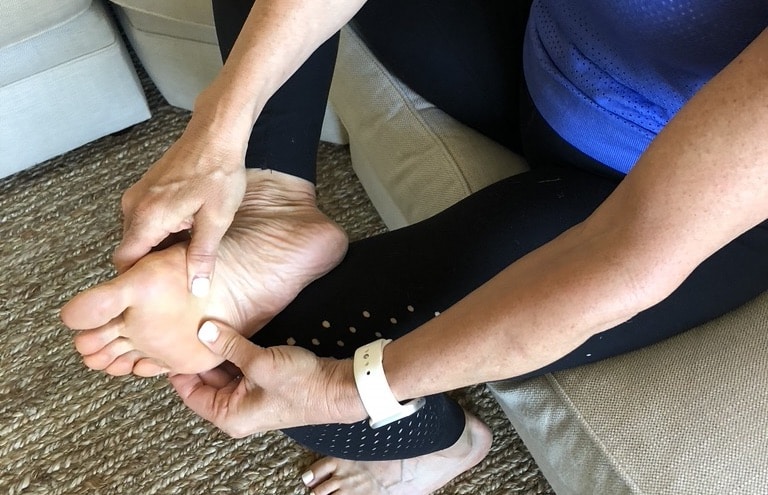
Alphabet Game
Next, sit up in bed and hang your legs over the side to play the alphabet game with your foot. Point your big toe and draw the alphabet from A to Z with each foot to strengthen and stretch the foot and calf.

Roll It Out
After the alphabet game, slowly stand up and place one foot on a massage ball, tennis ball, or frozen water bottle and slowly roll it across the bottom of the foot starting at the heel. Once you reach your toes go back slowly in the other direction.
Repeat 3 times for each foot.
Choosing a frozen water bottle gives you the bonus of reducing inflammation while the rolling massage helps you get prepared to step and move.

Plantar Fasciitis Stretches for Before or After Lunch
Incorporate these stretches for plantar fasciitis either before or after your lunch. They are perfect for the midday break.
Step Stretch
Find the nearest set of stairs and stand on the bottom step. Put the ball of the foot you want to stretch on the step and let the heel drop down for 30 seconds.
Switch to the other foot and do the same. Stretch each foot 3 times.
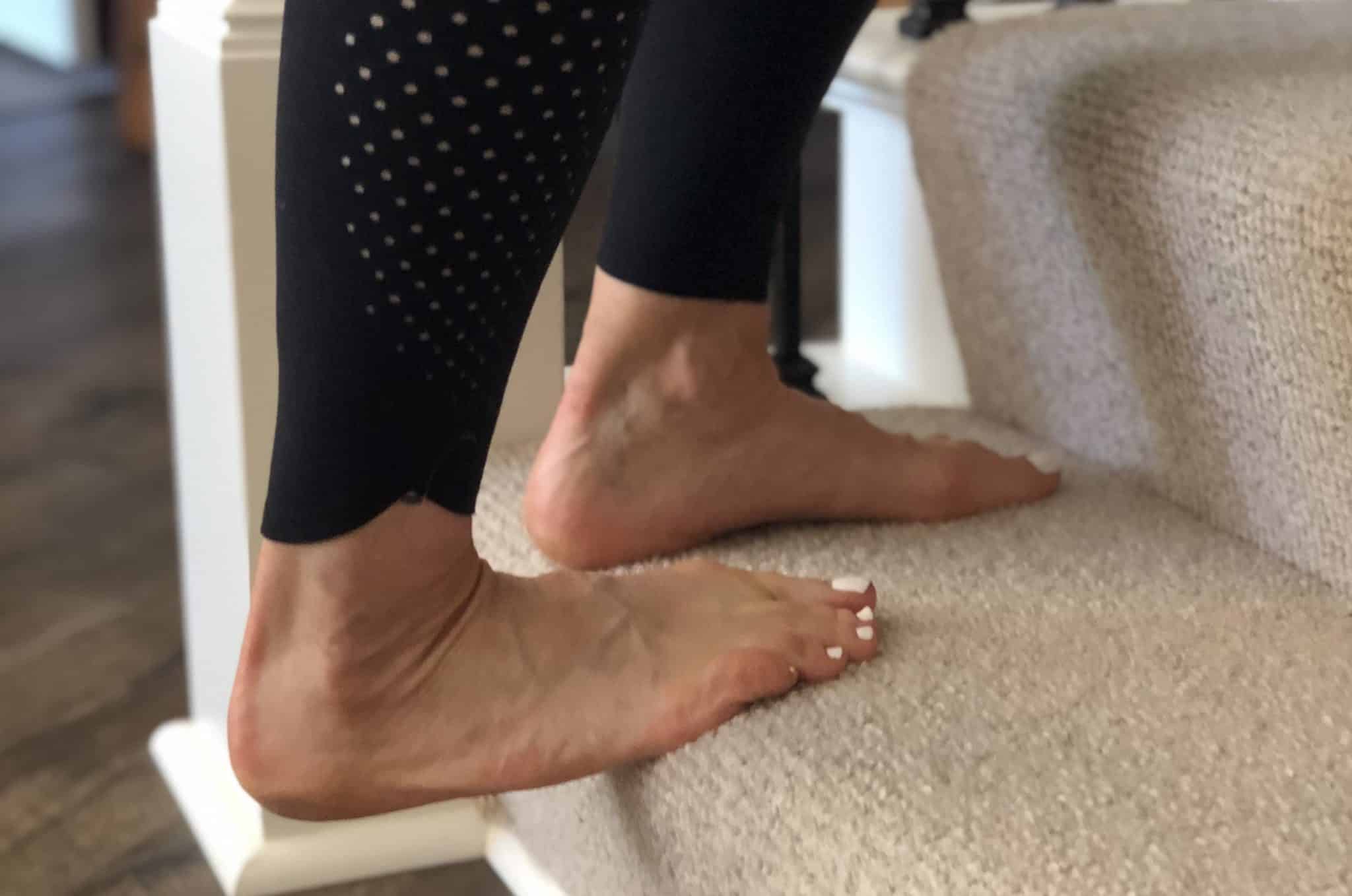
Heel Press
Stand facing a wall and place both hands against the wall. Step one foot back and press the heel of that foot firmly into the ground keeping your leg straight.
Move your hips forward until you feel a stretch in your calf.
Hold 30 seconds. Switch legs and repeat.
Try 3 times per foot. Don’t bounce! Remember that tight calves are often the origin of heel pain.
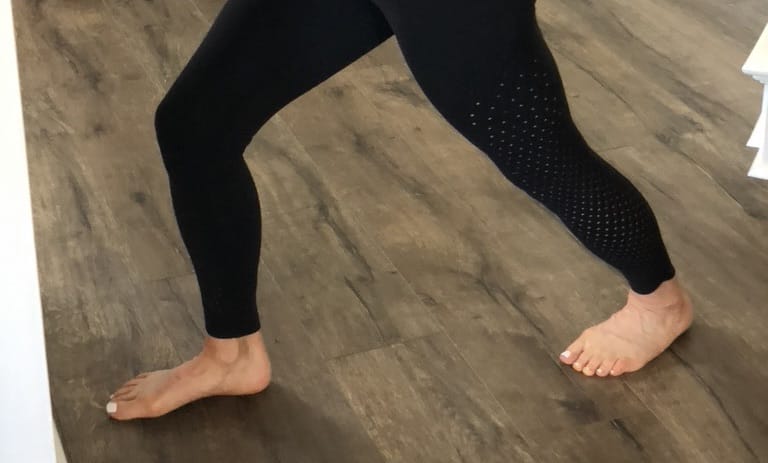
Plantar Fasciitis Stretches for Just Before Bed
Add these plantar fasciitis stretches to your bedtime to routine to finish of you day of exercises!
Washcloth Exercise
Sit on a chair or the edge of your bed with a washcloth on the floor. Keep your heel on the ground and lift the washcloth with your toes.
Release and repeat 10 times. Repeat on the other foot.
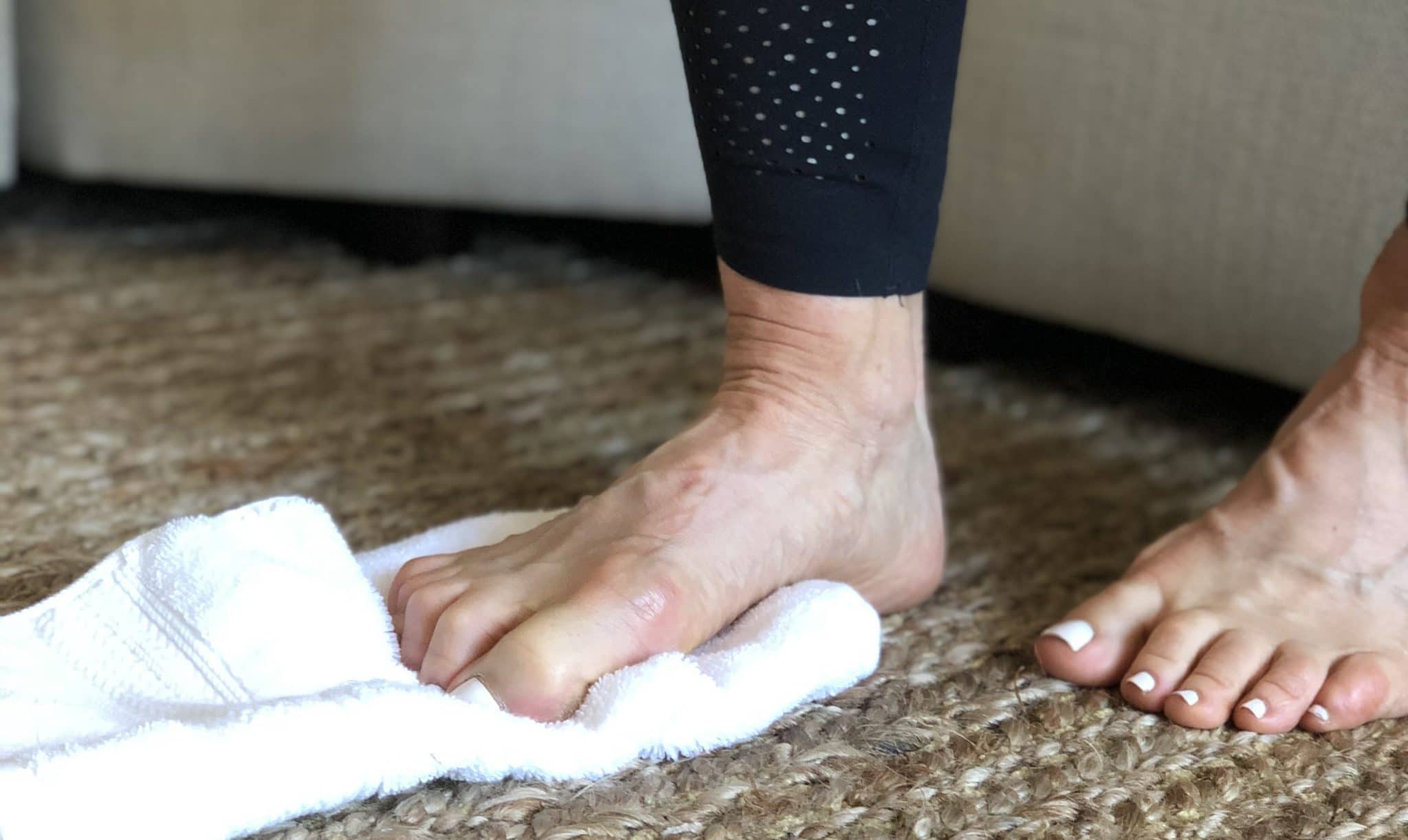
Seated Straight Leg Stretch
Grab a long band and or towel and sit down on the floor with your legs straight out in front of you. Place the band or towel around one foot, keeping that leg straight.
Gently pull back on the band or towel holding for 30 seconds and breathing gently.
Switch to the other floor. Stretch each side 3 times.
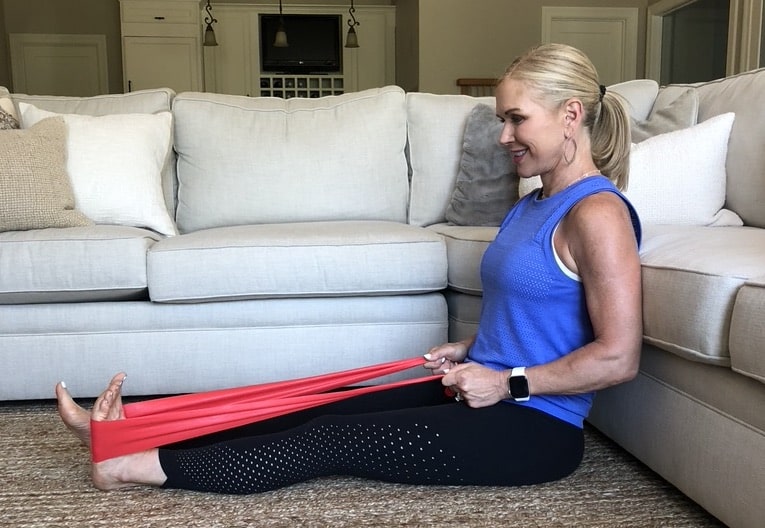
Additional Plantar Fasciitis Treatments
In addition to performing the above stretches for plantar fasciitis, you may want to add on some additional treatments.
When plantar fasciitis is treated early, most people resolve their pain with conservative treatments within six weeks. However, sometimes it takes a few treatments stacked on top of one another.
Here are some tried and true treatment options that can be utilized to relieve plantar fasciitis pain:
Ice
Just like with other injuries, the inflammation of plantar fasciitis can be helped with ice. The best way to do this is to use a frozen water bottle and roll it back and forth under your foot for about 10 minutes, several times a day. Do it at meals, under your desk while you work, or even at night when you watch TV. Be consistent.
Massage
No, you don’t have to pay for it. While you are sitting, roll a tennis ball around under your foot to massage the area. It works like a foam roller for your foot. Of course, the frozen water bottle also serves this purpose.
Medication
Over-the-counter anti-inflammatories can help. Ibuprofen or Naproxin are good bets to reduce inflammation and provide pain relief.
Rest
Your feet need time off from whatever is causing the issue. Stop or cut way back on high-impact exercises.
New Shoes
What a great prescription, huh? Most people wear their workout shoes for far too long before replacing them.
Remember that the plantar fascia muscle, which runs along the bottom of your foot, helps support the arch of your foot. So it makes sense that if you do not wear shoes with proper support you are putting extra wear and tear on that fascia. This leads to the muscle being strained and small tears can be created.
Also, many find relief by wearing supportive shoes or shoe inserts (more on that below) very regularly. Keeping shoes on as much as possible allows the fascia to heal more quickly and maintain support.
Check out my guide for what really matters in a walking shoe to get my expert tips!
Night Splits or Night Boot
Night splints (or a night boot) help relieve plantar fasciitis pain and was the most important thing I did to heal my plantar fasciitis many years ago. A night splint looks similar to a boot or sock.
You put it on your foot before you go to sleep, and the device lifts your toes and holds your foot in a gentle stretch all night long. By holding it in this flexed position, the tendon has a chance to heal.
Shoe Inserts For Plantar Fasciitis
Cheap or improper shoes can be one of the causes of plantar fasciitis, but before you go buying brand new shoes, you may also consider shoe inserts. Inserts last longer and can be moved from shoe to shoe as needed.
Here are some things to keep in mind when looking for shoe inserts:
- Look for insoles that have been well-tested and recommended by other users. If you don’t know someone personally, read the reviews online.
- Take time to know your own feet before you buy. Neutral? Pronator? Supinator? Get a diagnosis from a medical professional or a specialized running store that uses a treadmill to watch you and help you understand your gait.
- Look for inserts with deep heel cups. Generally, those who experience plantar fasciitis need more support in the arches of the feet. A deeper heel cup will provide this. Do you have flat feet? Low Arches? Moderate arches? If you aren’t sure, Runner’s World provides you with the Wet Feet Test that you can do at home to determine the amount of arch support you will need.
- Give the inserts time to break-in. Just like a new pair of shoes, the inserts will change the foot movement and your feet will need time to adjust. Do it in small doses.
Here are a few of our favorite options to help you get started:
- Airplus Plantar Fasciitis Orthotic
- Superfeet Black Premium Insoles
- Powerstep Protech Orthotic Supports
- Powerstep Unisex Pinnacle Maxx Insole
- GEL Orthotic Shoe Gel Insoles
Working Out with Plantar Fasciitis
So, is it okay to work out with plantar fasciitis? Yes!
Exercising with plantar fasciitis is, in general, something you can do. Just be aware that you may have to adjust your workouts until the problem is resolved and even then, make sure you resume your regular activities slowly.
There are two things to remember when you decide to work out with plantar fasciitis.
- It is critically important to wear proper, supportive shoes at all times! Even if you participate in water aerobics, there are shoes for you and you need to have them on!
- Participate only in things that will not contribute to the heel strike or pounding of your feet. Here are some suggestions.
Workouts To Try With Plantar Fasciitis:
These workouts are typically low impact: meaning they reduce the amount of impact that your foot will have to absorb.
- Swimming
- Water Aerobics
- Elliptical Machine
- Weight Lifting
- Cycling with hard surface shoes
- Rowing Machine
- Yoga
- Mat Pilates
Workouts To Avoid With Plantar Fasciitis
These workouts are typically high impact: meaning the amount of impact your foot will have to absorb is not recommended when dealing with plantar fasciitis.
- Running
- Jumping
- Bouncing
- Step Aerobics
- Walking for fitness
- Going barefoot or wearing flip-flops (use shoes even in your home!)
More About Plantar Fasciitis
Plantar fasciitis (“plan-tur-fash-ee-eye-tis”) is a common foot injury and a fairly easy one to fix if you act early.
The plantar fascia is a thick band of connective tissue that runs along the bottom of your foot connecting your heel to the base of your toes. It acts like a shock absorber supporting the arch in your foot.

If tension on the fascia is overloaded, tiny tears are produced resulting in irritation, inflammation and pain. The pain might feel like a stabbing sensation in the heel or arch of the foot, or it might feel more like deep aching or throbbing.
Most people feel this pain when getting out of bed in the morning. The pain generally subsides as the foot gets warmed up and moving.
This is because the fascia is contracted at night almost as if it tries to heal itself. When you step on it getting out of bed, a sudden strain occurs all over again.
If you have plantar fasciitis, you may be looking for exercises and stretches for relief and to help heal. And the sooner you start to treat plantar fasciitis the better since the longer you wait, the worse it typically gets and the longer it will take to heal.



I suffered this as well and when told by my very expensive Ortho doc to sleep with a night splint I said no thanks. I tried RoomMates a toe-tent that kept the weight off my feet and I was able to keep my foot stretched comfortably at night. I healed much faster with these. I now use them every night . check them out.
FYI – you cannot cure plantar fasciitis. Once you have torn your plantar fascia you cannot untear it you can only strengthened the muscles around it to help protect it in the future.
My son is 9 with this problem. How did he get it? Was he born like this?
My 10-year old daughter has suffered on and off for 3 years. At first we couldn’t believe that PF was actually what she had. We started with a better stretching routine (what 7 year old stretches before playing). We took her to a foot specialist and after some tests and X-rays they determined that she has an excessively large growth plate in her foot. At age 10 she already wears a women’s 8 1/2 shoe, so her PF is constantly being stressed. While still growing the growth plate has the texture of a pumice stone and continually aggravates her PF and Achilles tendon. The prescribed rest, ice, Advil and an orthodic lift (so the tendon stretches less). Although she did get better we see a flair up every time she has a growth spurt.
Bob – I would respectfully disagree. Fascia is a connective tissue, like a tendon or ligament. It is avascular (no circulation), but like all other connective tissue, relies on peripheral blood flow to heal. I have been working with occupational workers with PF for many years, and recently published a paper in the J Ergon. (2016:6:150). With proper foot care, rehab, inserts, and best work practices, this chronic condition can be cured. A good percentage of our industrial workers now have pain levels at zero after using inserts and rehab over time. Like a sprain in the joint – this type of connective tissue can heal. My experience is – that most people don’t take care of it like they would a sports injury.
Hi Chris!
Thanks for all your info…I absolutely love your advice and blog!
Barb Gillen
Great tips! Especially the workouts to do and avoid. If you were to give a massage to someone with plantar fasciitis, should it always have a rolling action? Or should I just ask where the pain is? Thanks!
I stopped going to yoga, started Barre and developed PF. I didn’t make the connection but after 8 months of pain, I finally thought that it could be Barre. My first doctor said I had flat feet and to start wearing SuperFeet inserts, ice, meds. My pain worsened but I am also very active and have a large active dog that needs 3 walks a day. I finally went to a very reputable Podiatrist who said custom orthotics are the best treatment for PF. I am now waiting to get fitted and hope this will work.
I have plantar fasciitis, my question is can it move up into the ankle area?
Hi Barbara – While plantar fasciitis technically would not be in your ankle, other areas can become affected either due to compensation or from tightness, etc. – so it all can be related but it wouldn’t be the same thing.
Hi Barbra. I have plantar fasciitis and I’m getting shooting pains up my ankles. I’m heading back to my podiatrist on Wednesday so will let you know what he says.
I’ve had plantar fasciitis for almost over a year, I used to be active 6 days a week down to 0. I’ve been seeing physio for 6months through my football team, and still no luck! Still just as bad as it has ever been. I have an active building job where I’m constantly on my feet on uneven surfaces. My physio says the only way I could get rid of it is to stay out of work until it’s gone which could take up to 8 weeks. I’m seriously considering the operation!
Please help me and give me any more advice I haven’t already heard and methods I haven’t already used! I’m pulling my hair out not being active! I’m depressed. It is a genuine issue this PF and I will forever sympathise with anyone carrying this terrible annoying injury!
Tried ALL of this, and then some. Still suffering going on three years. Feel hopeless. Even the doctors have given up on me…unless I take a nasty daily pain med indefinitely (no thanks), or opt for surgery!
Check into a procedure called a tenotomy (Tenex is the brand name). They make a small incision in the bottom of your foot and use ultrasound to break up the scar tissue. I had mine performed in an interventional radiology department. I wore a boot for 5-6 weeks and it 100% took care of the issue. It does take a few months to get back to 100%, but it’s better than the stabbing feeling I felt with every step.
I just got orthotics last week for my PF and the pain is worse?!Has any one else experinced this?
I too have plantar fasciitis. Went to podiatrist and got Orthotics which made my feet hurt more. Then I went for physical therapy for 6 weeks which helped, but my physical therapist told me that people with plantar fasciitis don’t necessarily need Orthotics. What they need to do is a lot of stretching. It’s been about a year since I first felt the pain on my feet and hasn’t completely gone away but it is getting better with no Orthotics. I started swimming instead of cardio and that seemed to help too
I got the diagnoses of pf with neuropathy 11years ago..i thought i was going to die my life was over..dramatic i know..but im a personal trainer and love to workout..i was in bed for weeks i was training for a marathon..i was just about there..running at6.0 for an hour a day..until that day came i felt nothing&off the tredmil i went..terrible..i went to the foot dr got the incerts &OMG the pain was worse..they did not work..i bought thousands of dollars in every kind of sneaker..nothing really helped.. well eventually the pain subsided off and on over these 11years..i havent had to see the foot dr..until now.. its been 2weeks i can barely walk the pain is rediculous..im waiting for a call with my appointment now..i bought gel soles and a few other things that were useless.. 60dollars later..and once again i was doing so good on the tredmil..i wasnt running longer then15mins..a lot of walking.35.000 steps a day down to 8.000…but now i cant do it.im so worried about gaining more weight.. i already gained 30pounds in the last three years and im miserable..i need my feet back😔theres a lot of helpful info i read on here ty..so to answer the question about the incerts no they didnt help me..i just turned50..am remarried after a21year marriage that failed..im completely happy with my life my husband but my feet and my weight..help.i need good working feet and if anyone has info on the best workout equipment for foot issues..that would be great i have a tredmil an eliptical a bike&a zillion videos..not working out for me as of now…
Pure magnesium oil spray that you rub into the soles up to your knees can really help! The Ancient Minerals brand is the purest. Chronic Inflammation in the body can be a cause of this. The oil is great for any kind of tendon/muscle inflammation, insomnia & a bunch of other stuff. A lot of pro-athletes use this.